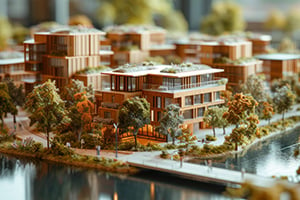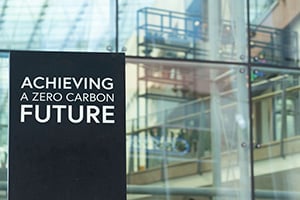By Farid Nat
Engineering Analyst
Sustainable Investment Group (SIG)
 The International Well Building Institute introduced its new WELL Health-Safety Rating as a means for buildings to have concrete guidance on how to create a safer indoor environment, with fewer risks of disease or infection. This rating is particularly timely and important as we are in the midst of a global pandemic and moving into a future where people are increasingly conscious of health risks around them. To achieve this new rating, a building must exhibit 15 out of 21 total features across 5 core areas. To get credit for the features the building must have met a variety of requirements that vary from feature to feature and some form of verification of the implementation of that feature. For a more general overview about this new rating system consider reading our first blog on the topic.
The International Well Building Institute introduced its new WELL Health-Safety Rating as a means for buildings to have concrete guidance on how to create a safer indoor environment, with fewer risks of disease or infection. This rating is particularly timely and important as we are in the midst of a global pandemic and moving into a future where people are increasingly conscious of health risks around them. To achieve this new rating, a building must exhibit 15 out of 21 total features across 5 core areas. To get credit for the features the building must have met a variety of requirements that vary from feature to feature and some form of verification of the implementation of that feature. For a more general overview about this new rating system consider reading our first blog on the topic.
Core Area 1: Cleaning and Sanitization Procedures
This first core area is focused on sanitization procedures in buildings because they are key areas for disease transmission. The features in this area provide some instruction on how to help ensure a clean building, while maintaining the use of environment and human-safe chemical cleaning agents. These features include:
- Support Handwashing
- Reduce Surface Contact
- Improve Cleaning Procedures
- Select Preferred Cleaning Products
The requirements for some of these features are:
- Support Handwashing: The building must have fragrance free hand soap dispensers, one of a variety of hand drying methods, such as paper towels, and signage displaying steps for proper handwashing and directing toward handwashing areas at the entrance for any food-related areas. This would be verified by an operations schedule and a letter of assurance from the owner.
- Select Preferred Cleaning Products: All cleaning products to be used in the building should be stated in the sanitization plan, and the products should be labeled as “low-hazard” or “safer” or have some third-party recognition. There should be no ingredients that are classified as Category 1, 1A, or 1B using the Globally Harmonized System of codes. Verification would be done by submitting the operations schedule.
Core Area 2: Emergency Preparedness Programs
After the outbreak of COVID-19 and its resulting effects on public health and the economy, many companies and buildings began to realize the importance of resilience and emergency preparedness. This area focuses on creating plans and procedures, so buildings can remain healthy immediately during re-entry after the COVID-19 pandemic, while also being prepared for future emergencies that may arise. The features in this section are:
- Develop Emergency Preparedness Plan
- Create Business Continuity Plan
- Plan for Healthy Re-Entry
- Provide Emergency Resources
- Bolster Emergency Resilience
Requirements for some of the features include:
- Create Business Continuity Plan: The project must have a Business Continuity Plan that outlines what the critical business functions are and the resources and staff needed for those functions, use a impact analysis to see the effects of events that may disrupt business, has a remote work readiness assessment, and defines strategies for continuity in the face of a variety of disasters. This feature is verified by the operations schedule.
- Bolster Emergency Resilience: To achieve this feature, the project must meet at least one of the following requirements: a designated space available for first responders for no cost use in an emergency, an Employee Assistance Fund for emergency use by employees, and a shelter-in-place plan for when tenants in the buildings can’t leave that has its own set of requirements. This would also be verified by the operations schedule.
Core Area 3: Health Service Resources
Maintaining employee health is a key tenet of this new rating system in WELL, and this core area provides a variety of measures a project can take to sustain a healthy working environment into the future. These measures include:
- Provide Sick Leave
- Provide Health Benefits
- Support Mental Health Recovery
- Promote Flu Vaccines
- Promote a Smoke-Free Environment
The requirements for a few of the features involve:
- Provide Sick Leave: The project should provide tenants with both short-term and long-term sick leave that is separate from paid time off and family leave, so that anybody feeling sick does not have to come in to work. This would be verified by a policy statement or operations schedule.
- Provide Health Benefits: A health benefits plan should be available to all employees and their dependents, and it should include the services of dental, medical, vision care, mental health, substance use, sexual and reproductive health services, and even more, as well as confidential benefits consultations for employees. This feature is also verified through the operations schedule or policy statement.
Core Area 4: Air and Water Quality Management
Since many people spend much of their time in indoors, poor air and water quality can cause easy transmission of disease or other health risks. Without proper treatment and assessment of air and water systems in a building, it is possible for a variety of health risks such as mold or viral infections in the air to become prominent. This section focuses on measures that can be taken to reduce the potential risk of these indoor threats. These measures include:
- Assess Ventilation
- Assess and Maintain Air Treatment Systems
- Develop Legionella Management Plan
- Monitor Air and Water Quality
- Manage Mold and Moisture
The requirements for some of the key features are:
- Asses Ventilation: The project must have a qualified engineer assess the indoor air quality by determining the highest possible rate of outdoor air supply, any modifications that could be made to increase outdoor air, how well the mechanical system can operate without recirculating air, and how the potential modifications would affect energy use, maintenance, and the ability to manage air temperature.
- Monitor Air and Water Quality: To achieve this feature the project should monitor and submit data for indoor air contaminants such as PM5, PM10, total VOCs, Ozone, Carbon Monoxide, which would be verified by an on-going data report. To test and verify water quality, an on-going data report describing the turbidity, pH, residual chlorine, and coliforms in the water.
Core Area 5: Stakeholder Engagement and Communication
Communication and Engagement with stakeholders can provide valuable information that helps maintain the wellness of occupants. Adequate communication on what emergency response and preparedness practices are present can help ensure that everyone knows what to do in the event of an emergency. On top of this, education on proper habits to promote personal health can contribute to increasing the overall wellness of the people in a building. The features and requirements for those features under this core area include:
- Promote Health and Wellness: To gain credit for this feature, the project must create a health-oriented mission that shows how wellness would be promoted, provide a feature guide explaining each of the features the project got credit for, and how those features impact occupant health, as well as giving regular communication about health resources. All of these would be verified by policy or an operations schedule.
- Share Food Inspection Information: For this feature, any food service locations within the project simply must have a publicly displayed hygiene and sanitation inspection report. This is verified by a letter of assurance.
Sources:
https://www.wellcertified.com/health-safety/
© 2020 Sustainable Investment Group (SIG). All rights reserved.



